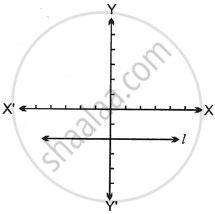Advertisements
Advertisements
Question
The lines represented by 4x + 3y = 9 and px – 6y + 3 = 0 are parallel. Find the value of p.
Solution
Writing the given lines 4x + 3y = 9
And px – 6y + 3 = 0 in the form of y = mx + c
4x + 3y = 9
`=>` 3y = −4x + 9
`y = (-4)/3x + 9/3`
`=> y = (-4)/3x + 3` ...(i)
Here, m1 = slope = `(-4)/3`
And px – 6y + 3 = 0
`=>` –6y = –px – 3
`y = (-p)/(-6)x - 3/(-6)`
= `p/6x + 1/2`
`=> y = p/6x + 1/2` ...(ii)
Here, slope m2 = `p/6`
∵ Lines are parallel
∴ Their slopes are equal i.e., m1 = m2
∴ `p/6 = (-4)/3`
`=>` 3p = –24
`p = (-24)/3`
p = –8
APPEARS IN
RELATED QUESTIONS
Without using the distance formula, show that the points A(4, −2), B(−4, 4) and C(10, 6) are the vertices of a right-angled triangle.
The side AB of an equilateral triangle ABC is parallel to the x-axis. Find the slopes of all its sides.

Find the slope and the inclination of the line AB if : A = `(-1, 2sqrt(3))` and B = `(-2, sqrt(3))`
Find the slope of the lines passing through the given point.
C (5, –2) , D (7, 3)
Find k, if PQ || RS and P(2, 4), Q (3, 6), R(3, 1), S(5, k).
Fill in the blank using correct alternative.
A line makes an angle of 30° with the positive direction of X– axis. So the slope of the line is ______.
Show that the line joining the points A(4, 8) and B(5, 5) is parallel to the line joining the points C(2, 4) and D(1, 7).
Find the slope of the diagonals of a quadrilateral with vertices A(1, 7), B(6, 3), C(0, –3) and D(–3, 3).
Find the slope of a line parallel to the given line 3x-2y = 5
In the figure, line l is parallel to X-axis. Which of the following statement is true?

